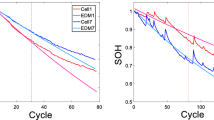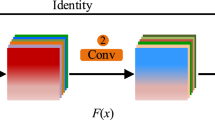Abstract
This paper presents a substantial assessment between a modified S-transform (MST) and the original S-transform (OST) for the identification of single and multiple power quality disturbances using probabilistic neural network, Gaussian support vector machines (SVM) and k-nearest neighbours (KNN). Disturbances are modelled using mathematical equations, and simulations are performed in MATLAB. Results show that compared to OST, MST can extract more accurate magnitude information from signals, with a better time resolution, both under noisy and noiseless conditions. The classification results based on four extracted features, three classifiers and five combinations of disturbances confirm that the performance of MST is better than OST in both the presence and absence of noise. SVM tends to have better classification accuracies under severe noise conditions, whereas KNN has a better performance under low noise and noiseless conditions. In this work, a first attempt was made to identify thirty-four types of single and multiple disturbances, and good classification accuracies were obtained. The results also depict that the identification accuracy is highly dependent on the combination of disturbances, thereby showing that no single feature set is suitable for all possible combinations of disturbances. Eventually, similar conclusions were drawn when the single disturbances were generated using the WSCC 9-bus test system.
















Similar content being viewed by others
References
Leonowicz Z, Lobos T, Wozniak K (2009) Analysis of non-stationary electric signals using the S-transform. COMPEL 28(1):204–210
Mahela OP, Shaik AG, Gupta N (2015) A critical review of detection and classification of power quality events. Renew Sustain Energy Rev 41:495–505
Khokhar S, Mohd Zin AAB, Mokhtar ASB, Pesaran M (2015) A comprehensive overview on signal processing and artificial intelligence techniques applications in classification of power quality disturbances. Renew Sustain Energy Rev 51:1650–1663
Zhang S, Li P, Zhang L, Li H, Jiang W, Hu Y (2016) Modified S transform and ELM algorithms and their applications in power quality analysis. Neurocomputing 185:231–241
Reddy MV, Sodhi R (2016) A rule-based S-transform and AdaBoost based approach for power quality assessment. Electr Power Syst Res 134:66–79
Sahu SS, Mansinha L, Tiampo KF (2009) Time localised band filtering using modified S-transform. In: 2009 International conference on signal processing systems, Singapore
Cerqueira AS, Ferreira DD, Ribeiro MV, Duque CA (2008) Power quality events recognition using a SVM-based method. Electr Power Syst Res 78(9):1546–1552
Ahila R, Sadasivam V, Manimala K (2015) An integrated PSO for parameter determination and feature selection of ELM and its application in classification of power system disturbances. Appl Soft Comput 32:23–37
Mahela OP, Shaik AG (2017) Power quality recognition in distribution system with solar energy penetration using S-transform and fuzzy C-means clustering. Renewable Energy 106:37–51
Rodriguez-Guerrero MA, Carranza-Lopez-Padilla R, Osornio-Rios RA, Romero-Troncoso RDJ (2017) A novel methodology for modeling waveforms for power quality disturbance analysis. Electr Power Syst Res 143:14–24
Singh U, Singh SN (2017) Application of fractional Fourier transform for classification of power quality disturbances. IET Sci Meas Technol 11(1):67–76
Wang H, Wang P, Liu T (2017) Power quality disturbance classification using the S-transform and probabilistic neural network. Energies 10(1):1–19
Liu H, Hussain F, Shen Y (2017) Power quality disturbances classification using compressive sensing and maximum likelihood. IETE Tech Rev 1–10. doi:10.1080/02564602.2017.1304290
Cunha Palácios RH, Nunes da Silva I, Goedtel A, Godoy WF (2015) A comprehensive evaluation of intelligent classifiers for fault identification in three-phase induction motors. Electr Power Syst Res 127:249–258
Khokhar S, Mohd Zin Asuhaimi A, Pervez Memon A, Safawi Mokhtar A (2017) A new optimal feature selection algorithm for classification of power quality disturbances using discrete wavelet transform and probabilistic neural network. Measurement 95:246–259
Han B (2013) The analysis of signal based on the S-transform. In: 2nd International conference on measurement, information and control (ICMIC), Harbin
Li Z, Ye M, Zhu M (2017) Generalized S transform and its application in mechanical fault diagnosis. In: Prognostics and system health management conference (PHM-Chengdu), 2016, Chengdu
Mishra S, Bhende C, Panigrahi B (2008) Detection and classification of power quality disturbances using S-transform and probabilistic neural network. IEEE Trans Power Deliv 23(1):280–287
Deng F, Guo S, Zhou R, Chen J (2015) Sensor multifault diagnosis with improved support vector machines. IEEE Trans Autom Sci Eng 99:1–11
Escalera S, Pujol O, Radeva P (2010) Re-coding ECOCs without re-training. Pattern Recognit Lett 31:555–562
Yu Z, Chen H, Liu J (2015) Hybrid k-nearest neighbor classifier. IEEE Trans Cybern 46(6):1263–1275
Viswanath P, Sarma TH (2011) An improvement to k-nearest neighbor classifier. In: Recent advances in intelligent computational systems (RAICS), 2011 IEEE, Trivandrum
IEEE (2009) IEEE Std 1159–2009—IEEE recommended practice for monitoring electric power quality
Kumar R, Singh B, Shahani D, Chandra A, Al-Haddad K (2015) Recognition of power-quality disturbances using S-transform-based ANN classifier and rule-based decision tree. IEEE Trans Ind Appl 51(2):1249–1258
Huang N, Xu D, Liu X, Lin L (2012) Power quality disturbances classification based on S-transform and probabilistic neural network. Neurocomputing 98:12–23
Uyar M, Yildirim S, Gencoglu T (2009) An expert system based on S-transform and neural network for automatic classification of power quality disturbances. Expert Syst Appl 36:5962–5975
Bholah A (2016) Simulink and probabilistic neural network based single power quality disturbances identification. University of Mauritius, Moka
Gonzalez-Longatt FM (2017) Power Systems Test Cases ::: Test Case P.M. Anderson Power System ::: Prof. F. Gonzalez-Longatt, unknown, 13 July 2015. http://www.fglongatt.org/Test_Systems/PM_Anderson.html. Accessed 3 June 2017
Tan RH, Ramachandaramurthy VK (2015) A comprehensive modeling and simulation of power quality disturbances using MATLAB/SIMULINK. In: Luszcz J (ed) Power quality issues in distributed generation. InTech, Rijeka, pp 83–107. doi:10.5772/61209
Khokhar S, Mohd Zin AA, Mokhtar AS, Zareen N (2015) Automatic pattern recognition of single and multiple power quality disturbances. Aust J Electr Electr Eng 13(1):43–53
Valtierra-Rodriguez M, Romero-Troncoso RDJ, Osornio-Rios RA, Garcia-Perez A (2014) Detection and classification of single and combined power quality disturbances using neural networks. IEEE Trans Industr Electron 61(5):2473–2482
Acknowledgements
This research did not receive any specific grant from funding agencies in the public, commercial or not-for-profit sectors.
Author information
Authors and Affiliations
Corresponding author
Ethics declarations
Conflict of interest
The authors declare that they have no conflict of interest.
Rights and permissions
About this article
Cite this article
Shamachurn, H. Assessing the performance of a modified S-transform with probabilistic neural network, support vector machine and nearest neighbour classifiers for single and multiple power quality disturbances identification. Neural Comput & Applic 31, 1041–1060 (2019). https://doi.org/10.1007/s00521-017-3136-z
Received:
Accepted:
Published:
Issue Date:
DOI: https://doi.org/10.1007/s00521-017-3136-z




